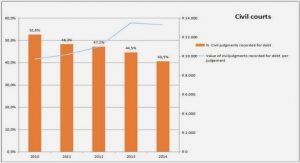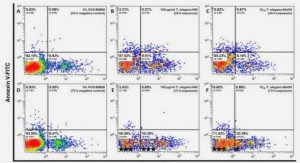Get Complete Project Material File(s) Now! »
Modelling wheel-rail contact mechanics
The forces generated in the contact patch depend on the elastic interaction between the wheel and rail as well as the friction between the two bodies. These forces can be subdivided into normal contact and tangential traction forces. It is possible to calculate the normal contact patch size and contact pressure distribution accurately by means of the finite element (FE) method. This is, however, computationally expensive. A simplified approximation is required to calculate the contact conditions readily. The half-space assumption limits the solution to areas where the contact area is small relative to the typical dimensions of the contacting bodies. In the railway system, these dimensions are usually the diameter of the wheel and the minimum radius of curvature near the contact (Kalker, 1990). This assumption therefore may be violated, should the point of contact be conformal. When these simplifications are applied to the normal contact solution, the half-space assumption may lead to large deviations from the true contact conditions. When tangential contact stresses are added to the problem, there is no suitable alternative to the elastic half-space assumption. To solve the normal problem, the position, shape and size of the contact patch and the distribution of the normal contact stresses are calculated from the local geometry of the two contacting profiles and the normal force acting between the two bodies. To solve the tangential problem, the tangential contact stresses and slippages are defined inside the contact patch and are calculated from the normal pressures and the creepage components.
Based on the listed simplifying assumptions and the assumption that the wheel and rail materials have similar Young’s modulus and Poisson’s ratio, the quasi-identity applies. The implication of the quasi-identity is that the tangential stresses will not affect the distribution of the normal pressures, which means that the normal and tangential problems are decoupled and can be solved separately (Kalker, 1990). The normal problem is commonly solved by applying Hertz’s theory. Here two contacting bodies are assumed to have constant curvature over a region that is wide enough to include the entire contact patch. By applying this condition and retaining the listed assumptions, it is possible to calculate an elliptic contact area and a semi-ellipsoidal pressure distribution. The size and shape of the contact patch are described in terms of the length () and the width () of the semi-axis of the contact ellipse. The maximum contact pressure is a function of the curvature of the two contacting bodies and the normal force acting between the two bodies. The contact patch size and pressure distribution are described by analytical formulae based on elliptical integrals, which make the solution of the normal problem by means of the Hertzian model, computationally efficient. If some or all the aforementioned assumptions are violated, the contact condition results in what is known as non-Hertzian contact. The assumption that the contacting bodies are continuous and non-conforming may, for example, become violated due to the contact position as well as wear causing the two contacting surfaces to become conformal. To solve the normal problem, strategies that are more complex have to be implemented. One strategy is to approximate the undeformed distance function by piecewise constant curvature polynomials and then to apply Hertzian theory to each, separately. This procedure is known as “multi-Hertzian” solution and the actual non-elliptical contact patch is approximated by the superposition of more than one Hertzian ellipse.
Vehicle dynamics modelling
With advances in digital computing and numerical methods, the solution of the dynamics problem by means of computer algorithms has received great attention. Various textbooks are available describing railway vehicle dynamics. These textbooks often start with the fundamental description and solution of single and multi-degree of freedom dynamic systems. The modelling of wheel-rail contact theories and the fundamental differential equations required to solve railway vehicle dynamics are introduced. The descriptions of the underlying differential equations start at the equations of motion of an unconstrained wheelset. The complexities present in the models increase from single wheelsets to bogie models and finally models addressing many degrees of freedom. These degrees of freedom include the longitudinal, lateral, vertical translational responses and roll, yaw and pitch rotational responses. These texts include good modelling practices and some provide examples of modelling complex subsystems such as coupler interaction or modelling of suspension elements (see Garg and Dukkipati, 1984; Wickens, 2003). The models described by Garg and Dukkipati (1984) are special-purpose models and are solved by algorithms developed specifically for these models. Further developments in this field resulted in the development of general computational multibody system algorithms that are capable of solving differential and algebraic equations in general. Shabana et al. (2008) described the basic equations used in such algorithms.
There are many commercial codes available to solve multibody dynamic systems or more specifically train vehicle dynamics. These software packages include Vampire, Gensys, Simpack, VI-Rail (previously known as Adams/Rail) and Nucars. Iwnicki (1999) compared the responses predicted by each of these packages to a set of predefined benchmark cases. In general, all the simulation packages showed good agreement. The wheel-rail contact algorithms have been extended to include the use of measured wheel and/or rail profiles during simulations. This allows further analysis of various combinations of influencing factors, as the behaviour of worn profiles might deviate significantly from the behaviour of new profiles. Simulations performed with such computer packages are used to study the performance of vehicles. The performance metrics are often related to vehicle stability, passenger comfort and the likelihood of derailment. The field of study and application of these codes have grown significantly. In recent years, these codes have been used in the study of wheel and rail damage in the form of wear and rolling contact fatigue (RCF). With more knowledge of these damage mechanisms, it is possible to predict the worn shape of wheels (Iwnicki, 2009; Dirks and Enblom, 2011) and to predict the initiation of surface-initiated RCF (Burstow, 2003; Burstow, 2004; Tunna and Urban, 2009; Wu et al., 2010; Dirks and Enblom, 2011). The complexity of the analysis may be further increased by including the effects of track irregularities. This complexity allows the researcher to perform a simulation over a track that represents deviations that are more realistic. Karttunen et al. (2014a) applied lateral irregularities to study their effects on the initiation of RCF. Berggren et al. (2008) have shown that vertical track irregularities with wavelengths shorter than 2 m produce high dynamic wheel-rail interaction forces.
Influence of wheel-rail profiles and vehicle dynamics on RCF initiation
The influence of the track on RCF initiation has been introduced in paragraph 1.2.2.2. The influence that the wheel and rail profiles have on RCF initiation will be dealt with in more detail. The profiles of the wheels and rails affect the contacting forces at the interface. These profiles therefore have a definite influence on the running behaviour of vehicles. It is thus obvious that the shape of the wheel and rail profiles will have an influence on the probability of RCF initiation. The wheel and rail profile combination should provide adequate stability in tangent track and facilitate steering in curved track. Due to the wear of these profiles, the straight-line stability and steering ability will change because of the change in equivalent conicity (Pearce, 1996). Pearce (1996) examined the worn shape of three different wheel profiles. In particular, a hollow-worn profile was produced by a vehicle with soft lateral suspension that ran over a relatively straight track. The increase in conformity between the hollow-worn wheel and the rail increased the conicity of the wheel in the high to very high region. Burstow (2003) studied the effect of very high equivalent conicity on the initiation of RCF. Based on the results from vehicle dynamics simulations of one site, it was determined that the RCF is caused by the worn state of some of the wheels. The wheel profiles became highly conformal with the rail profile causing a very high degree of equivalent conicity, resulting in vehicle instability. Due to the instability and the sharp changes in contact position, very high forces resulted in the contact patch. Such high forces would lead to an increase in the risk of RCF. This was proven by removing conformal wheel profiles from the analysis resulting in a reduction in the risk of RCF.
An increase in the equivalent conicity is caused by hollow-worn wheel profiles (Tournay and Mulder, 1996). This higher conicity causes larger lateral wheelset displacements and thus the wheel contact point to move laterally beyond the hollow wear band. It is known from Karttunen et al. (2014a) that lateral track irregularities have a significant impact on RCF initiation linked to larger lateral wheelset displacements. Tunna and Urban (2009) proved that conicity has a significant influence on the development of RCF damage on curves with radii larger than 1500 m. According to Evans and Iwnicki (2002), a low conicity wheel profile is more favourable from an RCF perspective, but it will produce more flange wear. Large lateral displacements, causing the wheel contact point to move beyond the hollow wear band, together with the instability of hollow-worn wheel profiles, will be aggravated by lateral irregularities. Large lateral displacements often result in the false flanges at both the flange and the field side of the wheel contacting the gauge corner and field side of the rail, respectively. This causes extremely small contact areas and often results in high longitudinal creepages due to the large radius differential generated by the wheelsets.
Chapter 1: Introduction and literature review
1.1 Introduction
1.2 Literature review
1.3 Scope of work
1.4 Dissertation overview
Chapter 2: Numerical model
2.1 Introduction
2.2 Vehicle model construction
2.3 On-track measurement of vehicle responses
2.4 Definition of the representative track
2.5 Comparison of on-track measurement and simulation results
2.6 Conclusion of numerical model validation results
Chapter 3: Influence of wheel and rail profile shape on the initiation of rolling contact fatigue cracks at high axle loads
3.1 Introduction
3.2 Vehicle dynamics
3.3 Processing of simulation results
3.4 Sensitivity of RCF damage parameters to profile shape features
Chapter 4: The success of rolling contact fatigue mitigation measures on wheel wear and rail fatigue
4.1 Introduction
4.2 Factors that influence rolling contact fatigue development
4.3 Wheel-rail interface damage
4.4 Methods
4.5 Results of wear and RCF damage prediction
4.6 Conclusion
4.7 Recommendations
Chapter 5: Long-term wear and rolling contact fatigue behaviour of a conformal wheel profile designed for large radius curves
5.1 Introduction
5.2 Wheel profile design considerations
5.3 Wheel-rail interface damage
5.4 Method
5.5 Wear and RCF damage prediction results
5.6 Conclusion
Chapter 6: Conclusion






